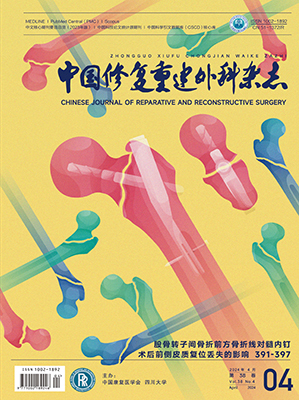| 1. |
顾玉东. 周围神经缺损的基本概念与治疗原则. 中华手外科杂志, 2002, 18(3):129-130.
|
| 2. |
Karagoz H, Ulkur E, Uygur F, et al. Comparison of regeneration results of prefabricated nerve graft, autogenous nerve graft, and vein graft in repair of nerve defects. Microsurgery, 2009, 29(2):138-143.
|
| 3. |
Khuong HT, Midha R. Advances in nerve repair. Curr Neurol Neuro-sci Rep, 2013, 13(1):322.
|
| 4. |
王胜. 体外诱导人脐血间充质干细胞分化为类许旺细胞的进一步实验研究. 蚌埠:蚌埠医学院, 2011.
|
| 5. |
沈江宁, 朱家凯. 坐骨神经指数在神经功能评价中的应用. 中华显微外科杂志, 1993, 16(4):284.
|
| 6. |
Bain JR, Mackinnon SE, Hunter DA. Functional evaluation of complete sciatic, peroneal, and posterior tibial nerve lesions in the rat. Plast Reconstr Surg, 1989, 83(1):129-138.
|
| 7. |
Ringe J, Kaps C, Burmester GR, et al. Stem cells for regenerative medicine:advances in the engineering of tissues and organs. Naturwissenschaften, 2002, 89(8):338-351.
|
| 8. |
Rodrlguez FJ, Verde E, Ceballos D, et al. Nerve guides seeded with autologous schwann cells improve nerve regeneration. Exp Neurol, 2000, 161(2):571-584.
|
| 9. |
陈明星, 欧阳桂芳. 脐血来源间充质干细胞的分化潜能. 中国组织工程研究, 2013, 17(32):5877-5882.
|
| 10. |
张娟, 刘峰, 张薇, 等. 人脐血间充质干细胞来源的外泌体:分离鉴定及生物学特性. 中国组织工程研究, 2014, 18(37):5955-596.
|
| 11. |
Sethe S, Scutt A, Stolzing A. Aging of mesenchymal stem cells. Ageing Res Rev, 2006, 5(1):91-116.
|
| 12. |
Robinson GA, Madison RD. Developmentally regulated changes in femoral nerve regeneration in the mouse and rat. Exp Neurol, 2006, 197(2):341-346.
|
| 13. |
Boucher A, Desforges M, Duquette P, et al. Long-term human coron-avirus-myelin cross-reactive T-cell clones derived from multiple sclerosis patients. Clin Immunol, 2007, 123(3):258-267.
|
| 14. |
Choi J, Enis DR, Koh KP, et al. T lymphocyte-endothelial cell interactions. Annu Rev Immunol, 2004, 22:683-709.
|
| 15. |
黄喜军, 朱庆棠, 江丽, 等. 去细胞异种神经复合同种异体脂肪干细胞修复猕猴周围神经缺损的免疫反应研究. 中国修复重建外科杂志, 2012, 26(8):993-1000.
|
| 16. |
杨润功, 衷鸿宾, 朱加亮, 等. 去细胞同种异体神经移植修复周围神经缺损临床安全性研究. 中华外科杂志, 2012, 50(1):74-76.
|
| 17. |
贾桦, 王莹, 张莲香, 等. 脱细胞异种神经移植体复合BMSCS修复大鼠坐骨神经缺损的研究. 牡丹江医学院学报, 2104, 35(5):1-4.
|
| 18. |
孙明学, 王鑫, 赵斌, 等. 化学去细胞法对粗大神经质量评价方法及影响因素的探讨. 中国修复重建外科杂志, 2006, 20(8):779-782.
|
| 19. |
宁仁德, 周建生. 改良冻融制备成年兔周围神经去细胞材料的研究. 蚌埠医学院学报, 2009, 34(4):287-289.
|




